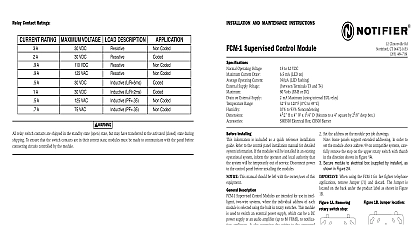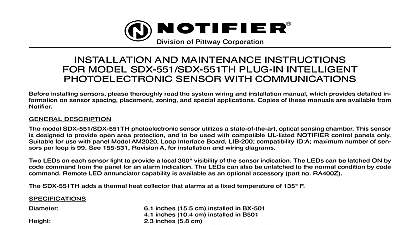Notifier FSP-751 and FSP-751T Intelligent Photoelectronic Smoke Sensors Installation and Maintenance Instructions

File Preview
Click below to download for free
Click below to download for free
File Data
| Name | notifier-fsp-751-and-fsp-751t-intelligent-photoelectronic-smoke-sensors-installation-and-maintenance-instructions-7420385691.pdf |
|---|---|
| Type | |
| Size | 426.41 KB |
| Downloads |
Text Preview
FSP 751 and FSP 751T Intelligent Photoelectronic Smoke Sensors and Maintenance Instructions sensor must be installed in compliance with the control panel system installation manual The installation must meet the requirements of the Authority Jurisdiction AHJ Sensors offer maximum performance when installed in compliance with the National Fire Protection Association NFPA see NFPA DESCRIPTION FSP 751 and FSP 751T are intelligent sensors that combine a state of the art photoelectronic sensing chamber with communications The FSP 751T thermal sensors that will alarm at a fixed temperature of 135 These sensors are designed to provide open area protection and are intended for use with control panels only LEDs on each sensor light to provide a local visible sensor indication Remote LED annunciator capability is available as an optional accessory Part No panels offer different features sets across different models As a result certain features of the FSP 751 or FSP 751T may be available on some control but not on others The possible features available in the FSP 751 and FSP 751T if supported by the control unit are The panel controls the LED operation on the sensor Operational modes are RED blink RED continuous GREEN blink and off The remote output may be synchronized to the LED operation or controlled independent of the LEDs refer to the operation manual for the UL listed control unit for specific operation of the FSP 751 and FSP 751T Voltage Range Current Alarm Current LED on Humidity Range Temperature Range Temperature Range recommends spacing sensors in compliance with NFPA 72 In low air applications with smooth ceilings space sensors 30 feet apart For specific regarding sensor spacing placement and special applications refer NFPA 72 or Notifier System Smoke Detector Application Guide available at charge from Notifier to 32 VDC 24 VDC one communication every 5 with LED blink enabled mA 24 VDC to 93 Relative Humidity noncondensing to 49 32 to 120 FSP 751 to 38 32 to 100 FSP 751T inches 43 mm installed in B710LP Base inches 155 mm installed in B710LP Base inches 104 mm installed in B501 Base oz 102 g ANNUNCIATOR Applications FSP 751 and FSP 751T are listed for use in ducts Duct Applications Guide A05 1004 for details on pendant mount applications These products are not listed for use inside duct smoke detectors INSTRUCTIONS wiring must be installed in compliance with the National Electrical Code applicable codes and any special requirements of the Authority Having Jurisdiction wire gauges should be used The installation wires should be color coded to wiring mistakes and ease system troubleshooting Improper connections will prevent system from respondingproperly in the event of a fire power from the communication line before installing sensors wiring must conform to applicable local codes ordinances and regulations RETURN LOOP 1 Wiring Diagram Do Not Loop Wire Under Terminal 1 or 2 Wire Run To Provide Supervision of Connections Ausbruchstelle 2 Rotary Address Switches Wire the sensor base supplied separately per the wiring diagram Figure 1 Set the desired address on the sensor address switches NOTE Some panels support extended addressing In order to set the sensor above address 99 on compatible Install the sensor into the sensor base Push the sensor into the base while turning it clockwise to secure it in place After all sensors have been installed apply power to the control unit and activate the communication line Test the sensor s as described in the TESTING section of this manual systems carefully remove the stop on the upper rotary switch with thumb as shown in Figure 2 covers provide limited protection against airborne dust particles during shipping Dust covers must be before the sensors can sense smoke Remove sensors prior to heavy remodeling or construction testing notify the proper authorities that the system is undergoing maintenance and will temporarily be out of Disable the system to prevent unwanted alarms sensors must be tested after installation and periodically thereafter Testing methods must satisfy the Authority Having AHJ Sensors offer maximum performance when tested and maintained in compliance with NFPA 72 The sen can be tested in the following ways TEST STATUS 3 1 I56 1230 06R Notifier 12 Clintonville Rd Northford CT 06472 203 484 7161 Functional Magnet Test P N M02 04 01 or M02 09 00 This sensor can be functionally tested with a test magnet The test magnet electronically simulates smoke in the sensing chamber testing the sensor elec and connections to the control panel 1 Hold the test magnet in the magnet test area as shown 2 The sensor should alarm the panel Two LEDs on the sensor are controlled by the panel to indicate sensor status Coded signals transmitted from the panel can cause the LEDs to blink latch or latch off Refer to the control panel technical documentation for sensor LED status operation and expected delay to alarm Smoke Entry Aerosol Generator Gemini 501 The GEMINI model 501 aerosol generator can be used for smoke entry testing Set the generator to represent 4 ft to 5 ft obscuration as described in GEMINI 501 manual Using the bowl shaped applicator apply aerosol until the panel alarms Direct Heat Method Hair dryer of 1000 1500 watts FSP 751T only Direct the heat toward either of the side thermistors Hold the heat source about 12 inches from the detector in order to avoid damage to the plastic The will reset only after it has had sufficient time to cool smoke and heat detection testing are recommended for verifying system protection capability sensor that fails any of these tests should be cleaned as described under CLEANING and retested If the sensor fails after cleaning it must be replaced and for repair testing is complete restore the system to normal operation and notify the proper authorities that the system is back in operation SENSITIVITY SETTING use of the 0.2 to 0.5 per foot sensitivity setting requires a 90 day test period to ensure that the detector environment is suitable for this setting The steps must be followed to meet Notifier and UL requirements for this high sensitivity application Each detector intended for 0.2 to 0.5 per foot alarm application shall have its initial alarm setting set for 0.5 obscuration per foot alarm level The initial setting for the detector shall be set to the intended alarm setting of the system Prealarm shall be set for nonlatching operation Detectors set at 0.2 to 0.5 per foot are intended for use in smoke free environmentally controlled applications such as computer rooms and clean rooms order to determine if an environment is suitable for installation the detectors shall be operated continuously for 90 days with all environmental factors temperature humidity air flow occupancy etc similar to the intended application for these detectors An electronic history file or printer shall be to record all events associated with the detectors under testing At the end of 90 days the results of the test shall be inspected by an authorized Notifier representative or the end user if trained by an authorized Notifier If no alarms or prealarms are recorded for the detectors under testing the system may be set to the tested prealarm level in the 0.2 to per foot range is recommended that the detector be removed from its mounting base to facilitate cleaning The detector is cleaned as follows Before removing the detector notify the proper authorities that the smoke detector system is undergoing maintenance and will be


